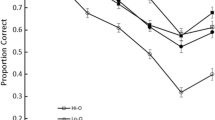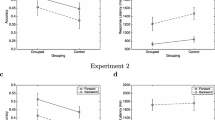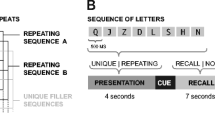Abstract
People often subdivide a list into smaller pieces, called chunks. Some theories of serial recall assume memories are stored hierarchically, with all-or-none retrieval of chunks, but most mathematical models avoid hierarchical assumptions. Johnson (Journal of Verbal Learning and Verbal Behavior, 8(6), 725–731, 1969) found steep drops in errors following correct recalls (transitional-error probabilities) within putative chunks during multi-trial letter-list learning, and viewed this as evidence for all-or-none retrieval. Here we test whether all-or-none retrieval occurs in lists studied only once. In serial recall of six-word lists (Experiment 1), transitional-error probabilities were inconsistent with all-or-none retrieval, both when participants were instructed to subdivide and when temporal grouping induced subdivision. Curiously, the same analysis of previous temporally grouped nine-letter lists produced compelling evidence for all-or-none retrieval, which may result from recoding rather than the formation of chunks. In Experiment 2, participants were pre-trained on three-word chunks. For nine-word lists constructed from those trained chunks, transitional-error probabilities exhibited more pronounced evidence of all-or-none retrieval. Nearly all effects reversed with post-cued backward recall, suggesting mechanisms that play out over the course of recall rather than encoding of the list. In sum, subdivided lists do not result in hierarchical memories after a single study trial, although they may emerge in lists formed from chunks that are previously learned as such. This suggests a continuous transition from non-hierarchical subdivision of lists to all-or-none retrieval over the course of chunk formation.







Similar content being viewed by others
Data Availability
Data are available at https://osf.io/hf2ka.
Notes
We thank Geoff Ward for this idea.
References
Anders, T. R., & Lillyquist, T. D. (1971). Retrieval time in forward and backward recall. Psychonomic Science, 22(4), 205–206.
Anderson, J. R., Bothell, D., Lebiere, C., & Matessa, M. (1998). An integrated theory of list memory. Journal of Memory and Language, 38, 341–380.
Anderson, J. R., & Matessa, M. (1997). A production system theory of serial memory. Psychological Review, 104(4), 728–748.
Anderson, R. B., Crawford, J. C., & Bailey, M. H. (2022). Biasing the input: A yokedscientist demonstration of the distorting effects of optional stopping on Bayesian inference. Behavior Research Methods, 54(3), 1131–1147.
Barrouillet, P., Bernardin, S., & Camos, V. (2004). Time constraints and resource sharing in adults’ working memory spans. Journal of Experimental Psychology: General, 133(1), 83–100.
Bireta, T. J., Fry, S. E., Jalbert, A., Neath, I., & Surprenant, A. M. (2010). Backward recall and benchmark effects of working memory. Memory & Cognition, 38(3), 279–291.
Bower, G. H. (1970). Organizational factors in memory. Cognitive Psychology, 1, 18–46.
Bower, G. H., & Clark, M. C. (1969). Narrative stories as mediators for serial learning. Psychonomic Science, 14(4), 181–182.
Brown, G. D. A., Neath, I., & Chater, N. (2007). A temporal ratio model of memory. Psychological Review, 114(3), 539–576.
Brown, G. D. A., Preece, T., & Hulme, C. (2000). Oscillator-based memory for serial order. Psychological Review, 107(1), 127–181.
Burgess, N., & Hitch, G. J. (1999). Memory for serial order: A network model of the phonological loop and its timing. Psychological Review, 106(3), 551–581.
Chen, Z., & Cowan, N. (2005). Chunk limits and length limits in immediate recall: A reconciliation. Journal of Experimental Psychology: Learning, Memory, and Cognition, 31(6), 1235–1249.
Cowan, N., Day, L., Saults, J. S., Keller, T. A., Johnson, T., & Flores, L. (1992). The role of verbal output time in the effects of word length on immediate memory. Journal of Memory and Language, 31(1), 1–17.
Cowan, N., Saults, J. S., Elliott, E. M., & Moreno, M. V. (2002). Deconfounding serial recall. Journal of Memory and Language, 46, 153–177.
Duncan, M., & Lewandowsky, S. (2005). The time course of response suppression: No evidence for a gradual release from inhibition. Memory, 13(3/4), 236–246.
Ericsson, K. A., Chase, W. G., & Faloon, S. (1980). Acquisition of a memory skill. Science, 208(4448), 1181–1182.
Ericsson, K. A., Delaney, P. F., Weaver, G., & Mahadevan, R. (2004). Uncovering the structure of a memorist’s superior “basic’’ memory capacity. Cognitive Psychology, 3, 191–237.
Farrand, P., & Jones, D. (1996). Direction of report in spatial and verbal serial short-term memory. Quarterly Journal of Experimental Psychology, 49A(1), 140–158.
Farrell, S. (2012). Temporal clustering and sequencing in short-term memory and episodic memory. Psychological Review, 119(2), 223–271.
Farrell, S., & Lewandowsky, S. (2004). Modelling transposition latencies: Constraints for theories of serial order memory. Journal of Memory and Language, 51(1), 115–135.
Frank, S. L., Bod, R., & Christiansen, M. H. (2012). How hierarchical is language use? Proceedings of the Royal Society of London B, 279, 4522–4531.
Frankish, C. (1985). Modality-specific grouping effects in short-term memory. Journal of Memory and Language, 24(2), 200–209.
Friendly, M., Franklin, P. E., Hoffman, D., & Rubin, D. C. (1982). The Toronto Word Pool: Norms for imagery, concreteness, orthographic variables, and grammatical usage for 1,080 words. Behavior Research Methods and Instrumentation, 14, 375–399.
Glanzer, M., & Fleishman, J. (1967). The effect of encoding training on perceptual recall. Perception & Psychophysics, 2(12), 561–564.
Gobet, F., Lloyd-Kelly, M., & Lane, P. C. R. (2016). What’s in a name? the multiple meanings of “chunk” and “chunking”. Frontiers in Psychology, 7 (102)
Grenfell-Essam, R., & Ward, G. (2012). Examining the relationship between free recall and immediate serial recall: The role of list length, strategy use, and test expectancy. Journal of Memory and Language, 67, 106–148.
Guérard, K., & Saint-Aubin, J. (2012). Assessing the effect of lexical variables in backward recall. Journal of Experimental Psychology: Learning, Memory, and Cognition, 38(2), 312–324.
Guérard, K., Saint-Aubin, J., Burns, S. C., & Chamberland, C. (2012). Revisiting backward recall and benchmark memory effects: A reply to Bireta et al. (2010). Memory & Cognition, 40, 388–407
Guitard, D., & Saint-Aubin, J. (2021). The irrelevant speech effect in backward recall is modulated by foreknowledge of recall direction and response modality. Canadian Journal of Experimental Psychology, 75(3), 245–260.
Guitard, D., Saint-Aubin, J., Poirier, M., Miller, L. M., & Tolan, A. (2019). Forward and backward recall: Different visuospatial processes when you know what’s coming. Memory & Cognition, 48(5), 111–126.
Haberlandt, K., Thomas, J. G., Lawrence, H., & Krohn, T. (2005). Transposition asymmetry in immediate serial recall. Memory, 13(3/4), 274–282.
Henson, R. N. A. (1998). Short-term memory for serial order: The Start-End Model. Cognitive Psychology, 36(2), 73–137.
Henson, R. N. A. (1996, November). Short-term memory for serial order (Doctoral dissertation). University of Cambridge.
Hitch, G. J., Burgess, N., Towse, J. N., & Culpin, V. (1996). Temporal grouping effects in immediate recall: A working memory analysis. Quarterly Journal of Experimental Psychology, 49A(1), 116-139.
Hulme, C., Roodenrys, S., Schweickert, R., Brown, G. D. A., Martin, S., & Stuart, G. (1997). Word-frequency effect on short-term memory tasks: Evidence for a redintegration process in immediate serial recall. Journal of Experimental Psychology: Learning, Memory, and Cognition, 23(5), 1217–1232.
JASP Team. (2023). JASP (Version 0.17)[Computer software]. https://jasp-stats.org
Johnson, N. F. (1969). Chunking: Associative chaining versus coding. Journal of Verbal Learning and Verbal Behavior, 8(6), 725–731.
Johnson, N. F. (1970). The role of chunking and organization in the process of recall. In G. H. Bower (Ed.), The psychology of learning and motivation advances in research and theory (pp. 172–247). Academic Press.
Kahana, M. J., Mollison, M. V., & Addis, K. M. (2010). Positional cues in serial learning: The spin-list technique. Memory & Cognition, 38(1), 92–101.
Kass, R. E., & Raftery, A. E. (1995). Bayes factors. Journal of the American Statistical Society, 90(430), 773–795.
Kowialiewski, B., Gorin, S., & Majerus, S. (2021). Semantic knowledge constrains the processing of serial order information in working memory. Journal of Experimental Psychology: Learning, Memory, and Cognition, 47(12), 1958–1970.
Kowialiewski, B., Lemaire, B., & Portrat, S. (2020). How does semantic knowledge impact working memory maintenance? computational and behavioral investigations. Journal of Memory and Language, 117 (104208)
Kowialiewski, B., Lemaire, B., & Portrat, S. (2022). Between-item similarity frees up working memory resources through compression: A domain-general property. Journal of Experimental Psychology: General.https://doi.org/10.1037/xge0001235
Lee, C. L., & Estes, W. K. (1981). Item and order information in short-term memory: Evidence for multilevel perturbation processes. Journal of Experimental Psychology: Learning, Memory, and Cognition, 7(3), 149–169.
Li, S.-C., Chicherio, C., Nyberg, L., von Oertzen, T., Nagel, I. E., Papenberg, G., & Bäckman, & L. (2010). Ebbinghaus revisited: Influences of the BDNF Val66Met polymorphism on backward serial recall are modulated by human aging. Journal of Cognitive Neuroscience, 22(10), 2164–2173.
Li, S.-C., & Lewandowsky, S. (1993). Intralist distractors and recall direction: Constraints on models of memory for serial order. Journal of Experimental Psychology: Learning, Memory, and Cognition, 19(4), 895–908.
Li, S.-C., & Lewandowsky, S. (1995). Forward and backward recall: Different retrieval processes. Journal of Experimental Psychology: Learning, Memory, and Cognition, 21(4), 837–847.
Liu, Y. S., & Caplan, J. B. (2020). Temporal grouping and direction of serial recall. Memory & Cognition, 48(7), 1295–1315.
Madigan, S. A. (1971). Modality and recall order interactions in short-term memory for serial order. Journal of Experimental Psychology, 87(2), 294–296.
Manning, S. K. (1982). Forward and backward recall in the suffix paradigm. Bulletin of the Psychonomic Society, 20(4), 199–202.
Manning, S. K., & Pacifici, C. (1983). The effects of a suffix-prefix on forward and backward serial recall. American Journal of Psychology, 96(1), 127–134.
Miller, G. A. (1956). The magical number seven, plus or minus two: Some limits on our capacity for processing information. Psychological Review, 63(2), 81–97.
Mızrak, E., & Oberauer, K. (2021). What is time good for in working memory? Psychological Science, 32(8), 1325–1337.
Murdock, B. B. (1993). TODAM2: A model for the storage and retrieval of item, associative, and serial-order information. Psychological Review, 100(2), 183–203.
Murdock, B. B. (1995). Developing TODAM: three models for serial-order information. Memory & Cognition, 23(5), 631–645.
Murdock, B. B. (2005). Storage and retrieval of serial-order information. Memory, 13(3/4), 259–266.
Norris, D., & Kalm, K. (2021). Chunking and data compression in verbal short-term memory. Cognition, 208 (104534)
Oberauer, K. (2003). Understanding serial position curves in short-term recognition and recall. Journal of Memory and Language, 49, 469–483.
Oberauer, K. (2022). When does working memory get better with longer time? Journal of Experimental Psychology: Learning, Memory, and Cognition, 48(12), 1754–1774.
Peirce, J. W., Gray, J. R., Simpson, S., MacAskill, R., Höchenberger, M. R., Sogo, H., & Lindeløv, & J. (2019). PsychoPy2: Experiments in behavior made easy. Behavior Research Methods, 5(1), 195–203.
Popov, V., & Reder, L. (2020). Frequency effects on memory: A resource-limited theory. Psychological Review, 127(1), 1–46.
Ritchie, G., Tolan, G. A., Tehan, G., Goh, H. E., Guérard, K., & Saint-Aubin, J. (2015). Phonological effects in forward and backward serial recall: Qualitative and quantitative differences. Canadian Journal of Experimental Psychology, 69(1), 95–103.
Ryan, J. (1969). Grouping and short-term memory: Different means and patterns of grouping. Quarterly Journal of Experimental Psychology, 21(2), 137–147.
Ryan, J. (1969). Temporal grouping, rehearsal and short-term memory. Quarterly Journal of Experimental Psychology, 21(2), 148–155.
Spurgeon, J., Ward, G., Matthews, W. J., & Farrell, S. (2015). Can the effects of temporal grouping explain the similarities and differences between free recall and serial recall? Memory & Cognition, 43(3), 469–488.
St. Clair-Thompson, H. L., & Allen, R. J. (2013). Are forward and backward recall the same? a dual-task study of digit recall. Memory & Cognition, 41, 519–532.
Tan, L., Ward, G., Paulauskaite, L., & Markou, M. (2016). Beginning at the beginning: Recall order and the number of words to be recalled. Journal of Experimental Psychology: Learning, Memory, and Cognition, 42(8), 1282–1292.
Thalmann, M., Souza, A. S., & Oberauer, K. (2019). How does chunking help working memory? Journal of Experimental Psychology: Learning, Memory, and Cognition, 45(1), 37–55.
Thomas, J. G., Milner, H. R., & Haberlandt, K. F. (2003). Forward and backward recall: Different response time patterns, same retrieval order. Psychological Science, 14(2), 169–174.
Ward, G., & Tan, L. (2019). Control processes in short-term storage: Retrieval strategies in immediate recall depend upon the number of words to be recalled. Memory & Cognition, 47(4), 658–682.
Ward, G., & Tan, L. (2023). The role of rehearsal and reminding in the recall of categorized word lists. Cognitive Psychology, 143 (101563)
Watkins, M. J., & Bloom, L. C. (1999). Selectivity in memory: An exploration of willful control over the remembering process [Unpublished manuscript]
Wickelgren, W. A. (1967). Rehearsal grouping and hierarchical organization of serial position cues in short-term memory. Quarterly Journal of Experimental Psychology, 19(2), 97–102.
Worthen, J. B., & Hunt, R. R. (2008). Mnemonics: Underlying processes and practical applications Byrne, J. H. (Ed.). Learning and memory: A comprehensive reference, 2, 145–153
Acknowledgements
Thanks to Madhawa Alahakoon and Briana Kroeker for work on earlier experiments that led to these ones.
Funding
Supported in part by the Natural Sciences and Research Council of Canada.
Author information
Authors and Affiliations
Corresponding author
Ethics declarations
This study was performed in line with the principles of the Declaration of Helsinki. Approval was granted by an Ethics Committee of the University of Alberta.
Additional information
Publisher's Note
Springer Nature remains neutral with regard to jurisdictional claims in published maps and institutional affiliations.
Supplementary Information
Below is the link to the electronic supplementary material.
Rights and permissions
Springer Nature or its licensor (e.g. a society or other partner) holds exclusive rights to this article under a publishing agreement with the author(s) or other rightsholder(s); author self-archiving of the accepted manuscript version of this article is solely governed by the terms of such publishing agreement and applicable law.
About this article
Cite this article
Shafaghat Ardebili, A., Liu, Y.S. & Caplan, J.B. The emergence of all-or-none retrieval of chunks in verbal serial recall. Mem Cogn 52, 352–372 (2024). https://doi.org/10.3758/s13421-023-01464-w
Accepted:
Published:
Issue Date:
DOI: https://doi.org/10.3758/s13421-023-01464-w




